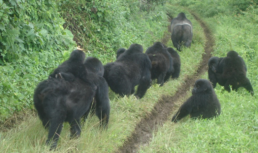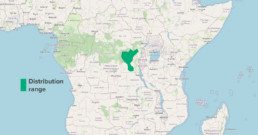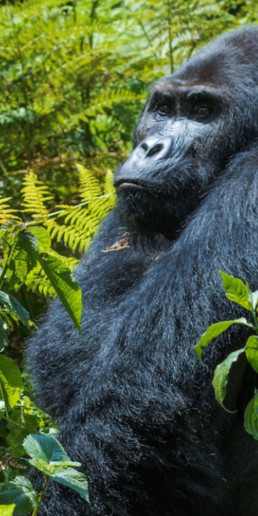⏺ Critically endangered
Grauer’s Gorilla, also known as the eastern lowland gorilla (Gorilla beringei graueri), is a Critically Endangered subspecies found exclusively in the mountainous forests of eastern Democratic Republic of the Congo. Primates in the DRC are primarily threatened by the mining of precious minerals at artisanal and industrial scale, poaching and pollution of soil and ground water.
Mining is the main driver of armed conflict in the region and stimulates human migration, wildlife trafficking, illegal logging for charcoal, colonization of forested areas, bushmeat hunting, and the construction of temporary roads in the forests. The extreme poverty in the region and the communities’ reliance on slash-and-burn agriculture are also drivers of great ape habitat degradation and fragmentation.
All of this has led to a rapid population decline of Grauer’s gorilla from an estimated 16,900 individuals in the wild in the mid-1990s to fewer than 3,800 individuals today.
The Soul of Congo's Forests

These gorillas have a remarkable jet black coat, reminiscent of their mountain gorilla relatives, but with shorter hair on both the head and body. As male Grauer’s gorillas mature, their once-black coat gradually transforms into a distinguished shade of grey, leading to the iconic designation of “silverback.”
The silverback, referring to the mature male leader of the group, stands out not only due to his silver-colored fur but also because of his impressive size and strength. These gorillas are the largest subspecies among their kind, and their robust build adds to their imposing presence in the dense, mountainous forests of eastern Democratic Republic of the Congo.
In the lush greenery of their habitat, Grauer’s gorillas navigate with a sense of grace, showcasing both power and agility. Their expressive eyes and thoughtful demeanor contribute to the overall aura of intelligence and complex social structure that characterizes these critically endangered primates.
Peaceful Leadership

Eastern lowland gorillas exhibit highly social and peaceful behavior, forming groups that range in size from two to over 30 individuals. Typically, a group comprises a dominant silverback, multiple females, and their offspring. The silverback, characterized by strength and leadership, serves as the protective leader (referred to as the alpha male), safeguarding the group from potential threats. As young silverback males mature, they gradually depart from their natal group, aiming to attract females and establish their own group.
The knowledge of the social behavior, history, and ecology of eastern lowland gorillas remains somewhat limited, partly because of civil war in the Democratic Republic of the Congo. Nevertheless, certain aspects of their social dynamics have been studied. For instance, gorillas form harems, occasionally including two fully grown males. Approximately one-third of gorilla groups in East Africa consist of two mature males.
Female gorillas undergo a gestation period of about 8½ months, giving birth to a single infant. The breastfeeding period lasts for approximately three years, during which infants remain with their mothers for three to four years. Female gorillas mature at around 8 years old, while males reach maturity at 12 years old.
Upon reaching maturity, both females and males typically leave their groups. Females often join another group or a lone silverback adult male, while males may temporarily stay together until they attract females and form their own groups. This group structure is believed to serve as a protective measure against predation.
East Africa's Ecological Jewel
Grauer’s gorillas, or eastern lowland gorillas (Gorilla beringei graueri), primarily inhabit the mountainous forests of the eastern Democratic Republic of the Congo within the broader region known as the Albertine Rift.
Recognized as a biodiversity hotspot, the Albertine Rift is home to an extraordinary array of plant and animal species, many of which are endemic. Its lush montane forests harbor critically endangered species like the Grauer’s gorilla, as well as other rare mammals, birds, and plants. The unique ecological conditions of the Albertine Rift contribute not only to the survival of numerous species but also play a vital role in maintaining regional and global biodiversity. The conservation of this ecologically rich area is paramount for the protection of its unique flora and fauna.


